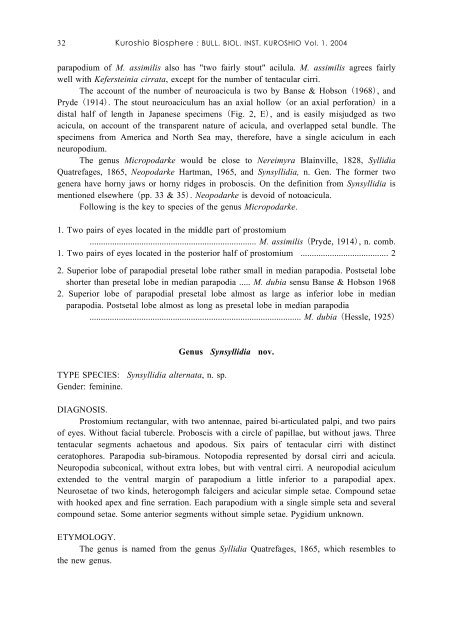HESIONIDAE (ANNELIDA, POLICHAETA) FROM JAPAN. I. by Hiro ...
HESIONIDAE (ANNELIDA, POLICHAETA) FROM JAPAN. I. by Hiro ...
HESIONIDAE (ANNELIDA, POLICHAETA) FROM JAPAN. I. by Hiro ...
You also want an ePaper? Increase the reach of your titles
YUMPU automatically turns print PDFs into web optimized ePapers that Google loves.
32 Kuroshio Biosphere : BULL. BIOL. INST. KUROSHIO Vol. 1, 2004<br />
parapodium of M. assimilis also has "two fairly stout" acilula. M. assimilis agrees fairly<br />
well with Kefersteinia cirrata, except for the number of tentacular cirri.<br />
The account of the number of neuroacicula is two <strong>by</strong> Banse & Hobson (1968), and<br />
Pryde (1914). The stout neuroaciculum has an axial hollow (or an axial perforation) in a<br />
distal half of length in Japanese specimens (Fig. 2, E), and is easily misjudged as two<br />
acicula, on account of the transparent nature of acicula, and overlapped setal bundle. The<br />
specimens from America and North Sea may, therefore, have a single aciculum in each<br />
neuropodium.<br />
The genus Micropodarke would be close to Nereimyra Blainville, 1828, Syllidia<br />
Quatrefages, 1865, Neopodarke Hartman, 1965, and Synsyllidia, n. Gen. The former two<br />
genera have horny jaws or horny ridges in proboscis. On the definition from Synsyllidia is<br />
mentioned elsewhere (pp. 33 & 35). Neopodarke is devoid of notoacicula.<br />
Following is the key to species of the genus Micropodarke.<br />
1. Two pairs of eyes located in the middle part of prostomium<br />
.......................................................................... M. assimilis (Pryde, 1914), n. comb.<br />
1. Two pairs of eyes located in the posterior half of prostomium ....................................... 2<br />
2. Superior lobe of parapodial presetal lobe rather small in median parapodia. Postsetal lobe<br />
shorter than presetal lobe in median parapodia ..... M. dubia sensu Banse & Hobson 1968<br />
2. Superior lobe of parapodial presetal lobe almost as large as inferior lobe in median<br />
parapodia. Postsetal lobe almost as long as presetal lobe in median parapodia<br />
.............................................................................................. M. dubia (Hessle, 1925)<br />
Genus Synsyllidia nov.<br />
TYPE SPECIES: Synsyllidia alternata, n. sp.<br />
Gender: feminine.<br />
DIAGNOSIS.<br />
Prostomium rectangular, with two antennae, paired bi-articulated palpi, and two pairs<br />
of eyes. Without facial tubercle. Proboscis with a circle of papillae, but without jaws. Three<br />
tentacular segments achaetous and apodous. Six pairs of tentacular cirri with distinct<br />
ceratophores. Parapodia sub-biramous. Notopodia represented <strong>by</strong> dorsal cirri and acicula.<br />
Neuropodia subconical, without extra lobes, but with ventral cirri. A neuropodial aciculum<br />
extended to the ventral margin of parapodium a little inferior to a parapodial apex.<br />
Neurosetae of two kinds, heterogomph falcigers and acicular simple setae. Compound setae<br />
with hooked apex and fine serration. Each parapodium with a single simple seta and several<br />
compound setae. Some anterior segments without simple setae. Pygidium unknown.<br />
ETYMOLOGY.<br />
The genus is named from the genus Syllidia Quatrefages, 1865, which resembles to<br />
the new genus.


